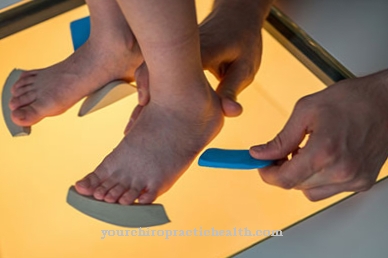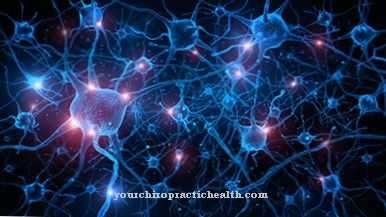Under Ledderhose's disease a benign connective tissue overgrowth in the sole of the foot is understood. The disease belongs to the fibromatoses.
What is Ledderhose's Disease?

© vladimirfloyd - stock.adobe.com
At Ledderhose's disease, also Ledderhose disease called, connective tissue grows in the sole of the foot. This leads to the formation of hardened knots that cause pain and limit the mobility of the foot. The disease manifests itself in the plantar aponeurosis (tendon plate of the sole of the foot).
Ledderhose's disease is classified as a fibromatosis. It is also related to Dupuytren's disease. While in Ledderhose's disease the soles of the feet are affected by lump formation, in Dupuytren's disease this is the case on the inner surfaces of the hands. The German doctor Georg Ledderhose (1855-1925), who described it, gave the benign disease its name.
Ledderhose's disease occurs twice as often in men as in women. The disease involves the slow growth of lumps that are concentrated in the center of the sole of the foot. Occasionally, the growth of the nodes can also be delayed so that they temporarily no longer enlarge. Later, their growth starts again and unexpectedly.
causes
Ledderhose's disease is caused by an increase in connective tissue. However, the causes of Ledderhose disease that trigger the growths are not known. Myofibroblasts, which are special cells, are responsible for the increase in connective tissue. Research is still being conducted in medicine into the precise relationships.
Various scientists assume the influence of a genetic component in the development of Ledderhose's disease. If the sole of the foot is injured, genetic factors cause changes in the connective tissue. In addition, the disease often occurs in families, which increases the likelihood of genetic influences.
Another important risk factor is the presence of other fibromatoses such as Dupuytren's disease. Diseases such as epilepsy or diabetes (diabetes mellitus) are also possible triggers. Liver and metabolic diseases, stress and the consumption of alcohol and tobacco are also counted among the favorable factors.
Symptoms, ailments & signs
Ledderhose's disease is noticeable on the tendon plate of the sole of the foot. There, knots form and harden. When the nodes reach a certain size, they make it difficult for the patient to walk. They are usually located in the middle of the sole of the foot on the arch of the foot.
While in some people only a single lump forms, it is more common in others. Even whole strands are possible. If the nodes are distributed over the entire sole of the foot, they grow together with the muscles and the skin that is above them. But there are also lighter forms of Ledderhose disease in which only a small part of the sole of the tendon plate is affected.
In addition, there are no adhesions on the muscles and skin. About a quarter of all patients have Ledderhose's disease on both feet. It is not uncommon for the disease to progress in phases, so that it can take years to progress.
Diagnosis & course of disease
To diagnose Ledderhose's disease, the doctor first surveys the patient. He informs himself about possible previous illnesses and whether certain risk factors are present. This is followed by a thorough examination of the soles of the feet. Other areas of the body are also checked for any abnormalities.
Hard knots are a typical indication. These can hardly be moved by hand. Imaging methods are used to determine the extent of the lumps. This primarily includes a sonography (ultrasound examination). Magnetic resonance imaging (MRT) can also be performed, with which the exact spread of the nodules can be recorded.
The diagnosis is confirmed by examining the nodes with a microscope. For this purpose, a tissue sample (biopsy) is taken from the patient. Ledderhose's disease is one of the benign chronic diseases. Complete healing is not possible. However, through appropriate treatment, it is possible to eliminate or at least reduce the symptoms.
Complications
With Ledderhose's disease, those affected suffer from various complaints, which mainly occur on the soles of the feet. The patients suffer from restricted mobility and, above all, from pain that occurs when standing and walking. The quality of life of those affected is significantly restricted and reduced by Ledderhose's disease. Other muscles can also be affected by the disease.
The symptoms, however, often do not appear permanently, but in episodes, so that the disease is diagnosed late. Due to the sudden restrictions on movement, those affected often suffer from depression or psychological complaints. In children, Ledderhose's disease can lead to development disorders and possibly delay them.
A causal treatment of Ledderhose's disease is unfortunately not possible. For this reason, the treatment is primarily aimed at limiting pain and restricted mobility. There are usually no complications. With the help of various therapies and the use of medication, many complaints can be narrowed down so that those affected can go about their everyday lives. However, Ledderhose's disease can also recur. However, the life expectancy of the patient is not affected by this disease.
When should you go to the doctor?
If a hard, immobile lump is noticed in the foot, a doctor should be seen. However, this does not necessarily mean Ledderhose's disease. The orthopedic surgeon is the contact person for pain or new lumps in the foot. The family doctor can also look at the foot and refer the person to a specialist if necessary.
If the diagnosis is unclear, magnetic resonance imaging can be ordered if Ledderhose's disease is suspected. To confirm the diagnosis, the doctor may do a biopsy to examine the lump further. The benign nature of the knot must be determined.
Regular visits to the doctor are normal if you have Ledderhose's disease. Surgical treatment unfortunately often leads to recurrences. It is therefore mostly avoided. The therapeutic approaches that are often prescribed slow down the spread of the nodal tissue. Special insoles can reduce pressure in benign fibromatoses. How often a doctor's visit is indicated to adjust the therapeutic measures depends on the extent of the growths.
The ulcers can be irradiated. Physiotherapy treatments are also possible for Ledderhose's disease. All therapeutic measures can at best slow the formation of knots. There is no cure in sight for the diagnosis of Ledderhose's disease.
Therapy & Treatment
One of the most important goals in the treatment of Ledderhose's disease is to reduce inflammation and pain. In addition, the patient should be able to walk again. Soft insoles are mostly used to maintain the ability to walk. These reduce the internal pressure that is created on the nodes.
To treat the pain, the doctor usually gives the person affected non-steroidal anti-inflammatory drugs (NSAIDs), which also affect the inflammation. At the same time, steroid injections are given into the nodes.
In the early stages of Ledderhose's disease, radiotherapy using soft X-rays is also considered to be promising. The injection of collagenases or shock wave therapy (ESWT) are also classified as useful. These lead to the loosening of the hard knots. Cryotherapy, in which the doctor treats the patient with cold, is also viewed as promising.
Surgical intervention may be necessary if it is at an advanced stage. It is not uncommon for the tendon plate to be completely removed. In contrast, partial interventions often lead to recurrence of nodes. However, even if the plantar fascia is completely removed, around 25 percent of all patients are at risk of renewed fibromatosis. The surgery can also injure tendons, nerves and muscles.
Outlook & forecast
Ledderhose's disease typically takes an intermittent course that lasts for several years. Nevertheless, the prognosis is very good. It is usually sufficient to remove the affected fascia and remove the trigger of Ledderhose's disease. The X-ray treatment results in radiation exposure, which can cause physical complaints under certain circumstances. Since mainly soft X-rays are used in the therapy of Ledderhose's disease, the risk of serious side effects is relatively low. The use of collagenase or shock wave therapy is also unproblematic and promising.
The prognosis is positive if the condition occurs as side effects from drugs such as primidone or phenobarbital. It is usually sufficient to stop taking the triggering medication. Life expectancy is not restricted by Ledderhose's disease. However, the quality of life can be reduced during the period of the illness, as the feet pain severely and the patient can hardly step on the soles without feeling intense pressure pain. Especially in the acute phase of suffering, this can lead to severe discomfort and restrictions in everyday life. The general practitioner or podiatrist can make a reliable prognosis taking into account the cause of the condition and the patient's condition.
prevention
How Ledderhose's disease develops has not yet been determined. For this reason, no preventive measures are known.
Aftercare
Medical follow-up care for Ledderhose's disease is only necessary if there is an operation. Otherwise follow-up measures are not required. Medication with a symptomatic effect or other, non-surgical treatment measures never require follow-up care. In some cases, treatment is not even available due to an acceptable level of suffering.
If an operation is carried out to remove the hardened tissue from the soles of the feet, a number of follow-up measures must then be observed. This can be explained by the fact that the feet are already heavily stressed in everyday life. This makes it much more difficult to heal the wounds and scars properly.
In addition to very pronounced protection of the feet, which can be achieved by the patient by not walking or standing, special wound hygiene must also be observed. Keeping it clean and protecting against sweat simplifies healing and prevents infections.
The responsible specialist must work out a corresponding healing plan with the patient depending on the extent of the operation. After a few weeks, when the soles of the feet have healed, the feet can gradually be loaded again. The extent to which this should be done gradually also depends on the scope of the operation. If only individual nodules are removed, the sole is less affected than with a full fasciactomy.
You can do that yourself
Since Ledderhose's disease is incurable, patients have to learn to come to terms with the disease in the long term. In some cases it is advisable to seek psychological help in addition to medical treatment. In addition, those affected can exchange ideas on self-help in various Internet forums. In larger cities there are also self-help groups for people who suffer from Ledderhose's disease or fibromatosis in general. There you will also find more information on self-help measures.
It is also important to care for your feet regularly and avoid injuries. Irritation of the soles of the feet should be avoided. When buying shoes, make sure that the shoes fit well. If necessary, those affected should resort to orthopedic custom-made items or use insoles. In some cases, regular barefoot walking over soft surfaces such as lawn, sand or mud helps. Cooling and gentle massages can also lead to an improvement or prevent deterioration.
It is also advisable to change your diet and reduce your intake of glucose and carbohydrates. Foods that contain many natural antioxidants have a supportive effect. It is therefore advisable to eat as much fruit and vegetables as possible, but also legumes. Alcohol and coffee can usually still be consumed in moderation.



.jpg)

.jpg)
.jpg)






.jpg)

.jpg)
.jpg)











.jpg)